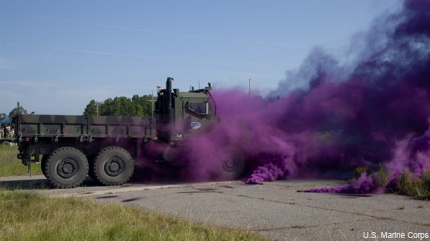Marine Corps, Army take autonomous convoys for a spin
Robotic vehicles react to IEDs and follow-the-leader in the latest demonstration of the Autonomous Mobility Applique System.

A simulated IED is set off during AMAS tests.
Designed to be equipped onto military transport vehicles, AMAS is a multiplatform kit that uses a Light Detection and Ranging sensor, GPS receiver, algorithm software package and a control system to enable autonomous control of convoys. In addition to operating autonomously, the system be remotely controlled and can warn human drivers about obstacles. Lockheed Martin was awarded an $11 million contract to develop AMAS in 2012.
The recent Joint Capability Technology Demonstration of the system is the result of a two-year collaboration between the Marine Corps and the Army to standardize technology that could enhance convoys, according to a Marine Corps release.
“The JCTD is a joint effort between the Marine Corps and the Army to come up with standardized robotic kits for their tactical wheeled vehicles,” said Bernard Theisen, the technical manager of the JCTD with the Army Tank Automotive Research, Development and Engineering Center. “Previously the Marine Corps had a program called Cargo (unmanned ground vehicle) and the Army had a program called convoy active safety technologies. These two programs merged together to form AMAS.”
The event included demonstrations of autonomous leader and follower scenarios, the remote control of vehicles equipped with AMAS, and the reaction of the system to simulated improved explosive devices. Researchers are hopeful that the technology could reduce the risk of IEDs to convoy personnel. IEDs have caused more than 2,300 U.S. service member casualties in Iraq and Afghanistan.
While the demonstrations highlighted the system’s capabilities, the services have acknowledged that some improvements are needed for AMAS.
“There are a lot of ways that the system can improve,” said Army 1st Lt. Robert Barnes, an officer of the 101st Sustainment Brigade. “Right now, it’s a commercial-level system. We can improve that by looking at the broad spectrum of some of the things in a wartime environment we don’t see in commercial vehicles every day.”
The AMAS system was first demonstrated by TARDEC and Lockheed Martin earlier this year. In that test, vehicles equipped with AMAS were able to detect and stay clear of slower vehicles and pedestrians and negotiate through intersections, oncoming traffic, and traffic circles. The Defense Department is hoping to complete the technology around 2020.
NEXT STORY: Army's air defense simulator gets a big upgrade



